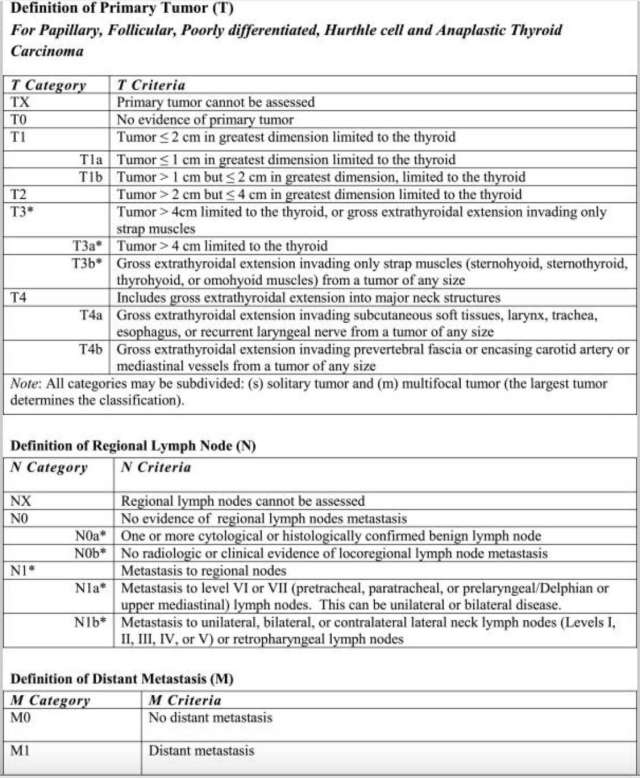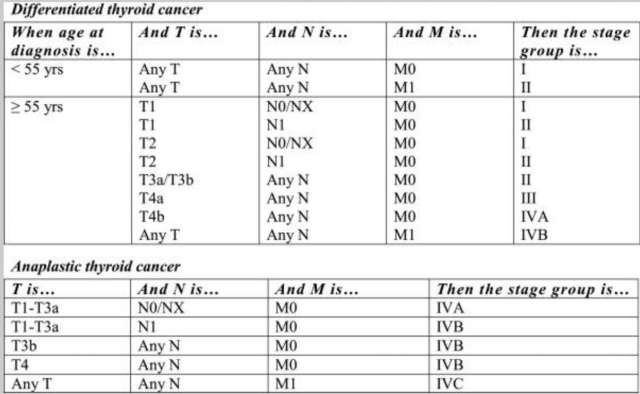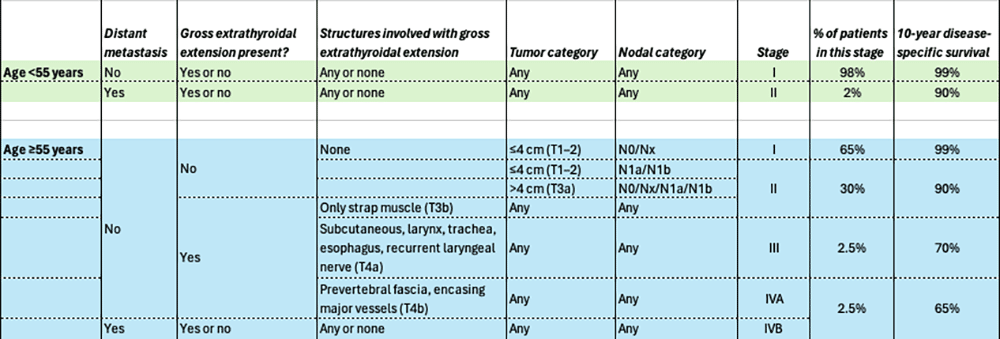Thyroid Cancer Staging
Hi, I ’m Dr. Michael Yeh with UCLA Endocrine Surgery, and today we're going to talk about thyroid cancer staging. Understanding cancer stages plays a vital role in determining the extent of the disease and its potential impact on a patient's prognosis.
By categorizing cancer into stages, we can better assess its severity and tailor our treatment plans to improve outcomes and ensure the patient's well-being over the long term. The purpose of cancer staging is to establish a correlation between the extent of cancer spread within a person ’s body and the prognosis, that is, the average duration of survival after a cancer diagnosis. In general, the further away a given cancer has spread away from its parent organ, the worse the prognosis.
To be honest, staging is not as widely employed in the case of thyroid cancer because, fortunately, most patients achieve excellent results with proper treatment. Indeed, more than 90% of thyroid cancer patients die of something other than thyroid cancer. Cancer staging encompasses four potential stages, with stage I indicating the least advancement, where cancer is confined to the primary organ, and stage IV corresponding to the most worrisome scenario, signifying extensive spread of cancer throughout the body.
Table 1:
American Joint Committee on Cancer eighth edition definitions for primary tumor (T), lymph node status (N), and distant metastasis (M).
For thyroid cancer, age plays a crucial role in determining the stage of the disease at diagnosis. Thyroid cancer is the only cancer in which the age at diagnosis factors into staging. This is because it has long been known that patients who are diagnosed with thyroid cancer at a more advanced age tend to do worse than younger patients.
Individuals under 55 years old can only be diagnosed with stage I or stage II thyroid cancer, as the likelihood of mortality (dying from thyroid cancer) in this age group is minimal. Under age 55, only the presence of distant metastases, to sites such as the lungs and bone, puts you into stage II. Everyone else, including those with locally invasive cancers and those that have spread to lymph nodes, is in stage I. Children and young adults in their 20s serve as good examples of this – though they frequently have many lymph node metastases of thyroid cancer when we meet them, these patients do exceedingly well over the long term, usually leading full lives without significant disability,
Table 2:
American Joint Committee on Cancer eighth edition stage groupings.
Now let ’s discuss patients age ≥55 years old. Again, most older patients present with stage I or stage II disease. However, in contrast to younger patients, patients age ≥55 years can potentially fall into all four stages. Stages I and II encompass patients with tumors that have not invaded critical organs in the neck. Though patients with stage I and II disease may have positive lymph nodes in the neck, their survival remains excellent. Stages III and IV encompass patients whose tumors have invaded organs such as the trachea or esophagus, major blood vessels, or the tissues near the spine. Patients with distant metastatic disease, that is, bloodborne spread of cancer to the lungs and bone, also fall into stage IV. Patients with stage III and IV disease are much more likely to die from thyroid cancer. These patients often require intensive, multimodal treatment under the diligent care of a multidisciplinary thyroid cancer team to maximize both survival and quality of life. From day to day, these patients with advanced thyroid cancer represent the greatest challenge we face at the endocrine center.
Table 3:
American Joint Committee on Cancer eighth edition stage groupings, with clinical descriptors, percentage of thyroid cancer patients in each stage group, and 10-year disease-specific survival.
In summary, most patients with thyroid cancer lead long and fulfilling lives without succumbing to the disease. Regardless of the prognosis, we are committed to caring for our thyroid cancer patients until the job is fully seen through. More than 90% of our patients are found to be disease-free one year after treatment. For those with more aggressive cancers, our multidisciplinary team of expert physicians works cohesively and efficiently, bringing the latest technologies to benefit our patients.
Key Insights:
- Cancer staging serves to establish a correlation between the degree of anatomic spread of a cancer and the patient ’s prognosis (duration of survival after the diagnosis of cancer).
- Thyroid cancer staging consists of four stages, with stage one being the least severe and stage four being the most severe. This staging system helps healthcare professionals communicate the extent of cancer and the likelihood of a patient's life being shortened by the disease.
- Patients under the age of 55 with thyroid cancer can only be in stage I or stage II. The chances of dying from thyroid cancer are low in this age group, even when the disease has spread beyond the thyroid gland.
- Patients age 55 and older with thyroid cancer may be in stage I, II, III, or IV. Stages III and IV encompass patients whose tumors have invaded important nearby organs. Patients with distant metastatic disease, that is, bloodborne spread of cancer to the lungs and bone, also fall into stage IV. In these stages, the risk of death from thyroid cancer becomes more likely.
- Despite the potential for advanced stages in older patients, most individuals with thyroid cancer live long, full lives and do not die from the disease. Multimodal care, employing the latest medical technologies, is essential to extending life in patients with advanced thyroid cancer.
Find your care
We deliver effective, minimally invasive treatments in a caring environment.
Call to connect with an expert in endocrine surgery.



